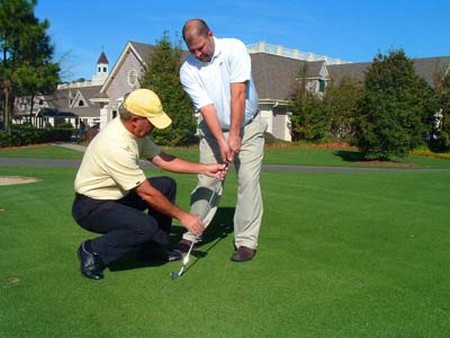For any golfer the hardest problem to overcome is an ingrained swing fault, one that he or she makes involuntarily because it is committed to what coaches call “muscle memory”. Whether you are aware of the problem or not it can be very difficult to rectify because it has become ingrained through repetition and the only way to fix the fault is by repeating the correct technique.
Coaches with a Professional Golf Certification will identify the problem and show you the correct technique but that is only the first step on what can be a long road to fixing your swing.

The golfer must be prepared to heed the professional’s advice and practise hard. But when away from the coach’s trained eye, you may fall back into the same bad habits or over-compensate. This is where training aids can provide invaluable benefits.
These come in many shapes and sizes, from simple items to elaborate designs but the principle behind them all is the same – to lock you into the correct technique through repetition. You then have the correct “muscle memory”, and can rely on your ability on the course.
The type of fault you have governs what type of training aid you require. Don’t think you need some wonderful apparatus to fix your problem. You may make do with something as simple as a tee.
Home-Made Trainers
For instance, if you take the club away from the ball wrongly, you can simply put a tee in the ground about two feet behind the ball on the correct line. Swing back towards the tee, and you are using a very effective training aid.
Your feet are wrongly aligned? You need only to place a club on the ground pointing in the right direction. Place your toes just behind the shaft and again you have an ideal guide to the correct alignment.
Let’s say your problem is hitting from the top, an action in which you tend to cast your hands away from your body at the start of your downswing, making you chop down on the ball or hit from the outside and across it. Practise by swinging a straw broom to give you the feeling that the club head is lagging behind your hands on the downswing. The wind resistance to the head of the broom will create that feeling which you will then be familiar with when swinging a golf club.
A similar problem with a different remedy. You are hitting from outside to in or from too much on the inside of the target line before impact and outside the line after impact.
A popular training aid is a simple piece of timber, usually 4×2 inches thick and about three feet long which is placed just outside the ball, pointing along the target line.
If you hit from the top and the clubhead approaches the ball from the outside, you will hit the timber on the way down. Too much from the inside and you hit the timber after impact. Simple, but brillantly effective. You soon forget about the ball and concentrate on swinging the club properly so that you don’t hit the wood.
You may, however, need to use one of the elaborate inventions on the market, and there are a number of very good ones about.
Moulded Grip
As the name suggests, it is a grip which is shaped to make you place your hands in the right position when gripping the club. A number of professionals have these but the problem is catering for golfers with different-sized hands.
It is also unlikely that the club to which this grip is fitted will have the right shaft, lie, weight and loft for you, and so any shots you hit could give you a false impression.
It is better that you know the correct grip position and make sure you stick with the change. Accept the fact that changing your grip is one of the hardest things to do and be prepared to hit a lot of practice balls until you are comfortable.
Full-Swing Trainer
This is an impressive but quite simple device which has a large, circular moulding fitted to an adjustable frame. The golfer stands inside the circle which is angled so that the top of the circle is above and behind your shoulders and the bottom below and in front of your knees.
The circular frame is usually made from a heavy-duty, smooth plastic which allows you to make a normal swing, all the time concentrating on keeping the shaft of your club in contact with the frame. It trains you to swing the club in the right plane and arrive at the ideal position at the top of your swing whereby the clubhead is pointing down the target line.
If the club is coming away from the frame then you are throwing it across the target line. If you feel you are putting too much pressure against the frame then you are letting the club fall away from the target line.
Because the supporting frame is adjustable, the trainer will accommodate golfers of all dimensions.
Harness
Many coaches these days subscribe to the swing principle of keeping your arms close to your body throughout your swing which is the method Nick Faldo uses, hence its popularity.
For those who want to swing this way, a common drill is to place a towel across your chest and hold it in place with your arms throughout the swing.
Taking this a step further is a customized, adjustable belt which is tightened around each arm and across your chest so that no matter how much you try to hit with your arms away from your body, you can’t.
Putting Trainers
They have been marketed in recent years to help you develop a sound, repetitive stroke. One popular drill which has been practised by golfers for many years is placing two rows of tees in the ground, leaving you just enough room to swing in between.
What we now see are trainers designed to do the same thing. One developed in Australia, The Puttmaster, has a slightly curved rail near ground level onto which the shaft of your putter is clamped, and you swing along the rail on the correct path.

It can be adjusted to accommodate more than a dozen strokes: inside to out, straight back and straight through, inside to inside and more. You choose the stroke you think is right for you and practise it on the trainer, gradually becoming comfortable with that action.
Another device is a T-shaped frame with a curved cross-bar bending around your chest and held in position under your armpits. You attach the down-bar to your putter shaft beneath your hands. The frame is made of light material and doesn’t feel awkward when you stroke your practice putts. The aim is to take any wrist movement out of your putting stroke, making your hands, arms and shoulders work as one unit, which is widely regarded as the most reliable way to putt.
There are many training aids on the market. Those I have mentioned should give you an idea as to what can be used to help your game. Have a look around but make sure you have a good understanding of what the trainer you choose is designed to do. If not, seek the advice of a qualified professional. Check out the best Spanish Golf break deals for the best courses to practice your swing.